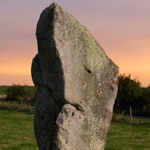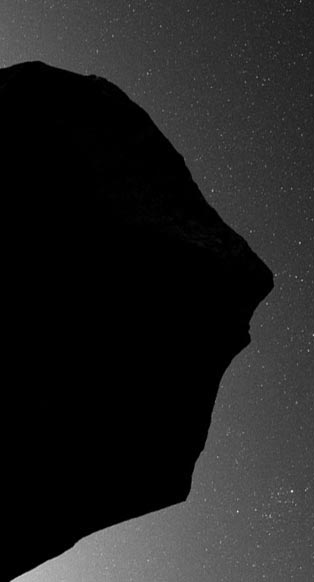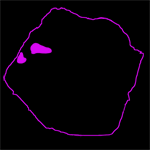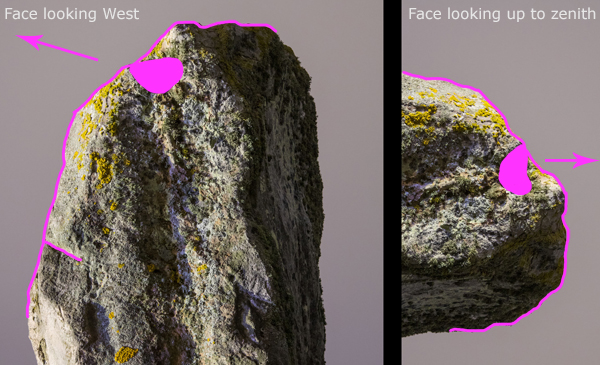|
01. Actual Simulacra
The first thing to be freely acknowledged is that many features at Avebury that resemble people/animals are not man made. We say that these are mere accidental features in the rock that the human mind imposes an interpretion on to (a là Rorschach test). These are still valuable indications of how our predecessors saw the world as the simulacra were selected.
Below I show a simulacrum of a bird (my discovery) and also that of the famous "shark". These are both probably natural, not carved. There are many simulacra at Avebury, I state this clearly to show that I am not rushing to say that every feature on a stone is man made.
|
| |
|
|
 
|
| |
|
|
02. Carvings Depicting Living People Or Humanoid Gods
Many heads are clear profiles of human beings, both male and female. Meaden suggests that profiles looking left are female, those looking right are male, and I show examples of both below:
|
| |
|
|
|
| |
|
|
03. Images Of The Feminine
Avebury clearly has a central concern with celebrating the feminine with several carved or natural representations of vulvas. These are part of the reason Avebury can be identified as a temple dedicated to the Great Goddess, the creatrix of the world and its perpetual cycle of death and rebirth. Below are two Avebury vulvas, one natural, one sculpted:
|
| |
|
|
 
|
| |
|
|
|
04. Carvings Depicting Dead People Or Representations Of Death
The Neolithic was obsessed with the afterlife and the importance of ancestors. It should therefore be no surprise to see dead faces at Avebury. Below I show a giant skull (my discovery) and also the face of a dead person undergoing excarnation by birds (my original explanation of this stone):
|
| |
|
|
 
|
| |
|
|
|
05. Carvings Of Animals (Theriomorphs)
There are lots of animals carved into the stones of Avebury. Particularly clear examples are the hare and bull images below (the bull was my discovery):
|
| |
|
|
 
|
| |
|
|
|
06. Half-Reliefs
Heads carved in the round but with the side of the face closest to the viewer left undeveloped. Seems to me to symbolize the concealed nature of the spirits underwriting the neolithic world - a celebration of the still common intuition that there is a foundational reality lying just out of sight of ours. Animism just under the surface of all things, a subtle concept requiring a subtle artistic sculptural technique. It is Avebury's honouring of such ineffable human feelings that explains part of its mesmerising attraction for many modern visitors.
|
| |
|
|
 
|
| |
|
|
|
07. Zenith-Seekers
Seems to me a key Avebury motif, strong faces looking absolutely straight up. My guess is that they may be looking up to the stars, or else to see faces in the daytime clouds. Some zenith-seekers have living human faces, others appear to be flattened skulls, and at least one appears to be a snake:
|
| |
|
|
  
For more examples of the zenith-seekers please click here
|
| |
|
|
|
08. Equator-Seekers
A class of star-gazing faces that populate the West Kennet Avenue. Possessing developed or rudimentary faces (some no more than flat surfaces, some with an eye socket) that look up in the general direction of where the celestial equator meets the meridian high to the south:
|
| |
|
|
 
Above are images of Stones 36a and 35b
|
| The two images below have been rotated, and in one case flipped side-to-side, to more easily show that these equator-seeking stones from the WKA have astonishingly similar profiles, again proving that they are artificial, man-made works of art: |
| |
|
 
Above are images of Stones 13a and 26a
For more examples of the equator-seekers please click here
|
|
|
09. The Cove Character
At least 2 monoliths associated with the Cove appear to be mirror images of the same character, with distinctive foreheads, noses and sculpted mouths:
|
| |
|
|
 
|
| |
|
|
|
10. Lozenges or Diamonds
Lozenge or diamond shaped monoliths are particular features at Avebury. The lozenge is a shape strongly associated with femininity:
"On its own, the triangle ........ symbolises the vulva and pubic zone by which it stands for the Great Mother as the source of all life. At the same time it is the sign of the original trinity - the triple goddess in her three ages of maiden, mother and wise woman. The lozenge symbol goes farther, for it is made up of two triangles base to base, in which the upward pointing triangle can indicate
the navel triangle ...." (Meaden, "Secrets" p 4).
|
| |
| |
|

|
| |
|
| Lozenge stones sometimes appear quite plain, but may sport corner or recursive faces described below in points 11 and 12. |
| |
|
|
11. Corner Faces
Many of Aveburys' lozenge shaped stones have had faces incorporated onto their corners:
|
| |
|
|

In fact I am beginning to suspect that Avebury monoliths with sharp sideways pointing corners generally represent stylised or shorthand versions of the amazing "beaky" face I discovered on Cove Stone I (click here for details)
|
| |
|
|
|
12. Recursive Faces
1. Corner or Zenith-Seeking Recursives
Some of the corner faces on lozenge shaped stones are recursive, as are some zenith-seeking ones of the top of monoliths (click here for an example), they include duplicate sets of eyes sharing the same features, as if two faces were superimposed at different scales:
|
| |
|
|

|
| |
|
|
I have identified a similar recursive face on the northern side of the famous Swindon Diamond Stone in the henge's north-west quadrant, reminds me of a bird of prey's head gazing towards the east. Unfortunately to photograph this properly I would have to stand in the road which at night would be suicidal, so for now a crude location sketch will have to do!:
|
| |
|

|
| |
|
2. Interior Recursives
Although I first noticed recursive faces on the corners of lozenges they can also exist on the flat interiors of stones, please click here to learn more, and scroll down to see figures 3,4,5 on that page.
|
|
|
13. Faces At Right Angles Sharing An Eye
A particular Avebury style of sculpture is to have a sideways looking vertical face (in the image below we have a horse looking left) with a horizontal upwards looking face, the key point is that both faces share or pivot round the same eye:
|
| |
|
|


|
| |
|
|
|
14. The "D" Faces
A very very common Avebury style is to have a rounded "D" shaped edge to a monolith, with either a natural or carved eye making a rudimentary face. The eyes in the 2 faces below look natural to me, but others are definitely carved:
|
| |
|
|
 
|
| |
|
|
|
15. Faces Created With Stone Mauls
There is no controversity at all among archaeologists that the Trilithons at nearby Stonehenge were hammered into shape using round stone mauls. Seems to me equally apparent that mauls were also used at Avebury to great sculptural effect:
|
| |
|
|
 
|
| |
|
|
|
16. Faces Economically Created Using Simple Short Lines To Represent Eyes
Sometimes our ancestors converted suggestively shaped stones into mythological faces simply by carving strategically placed short lines:
|
| |
|
|
  
|
|
|
17. Themed Pairs Of Sculptures
Some Avebury sculptures are created side by side with a clear theme in common, like the two (possibly female) singing faces on Stone 35a WKA, probably set there to greet the rising sun/moon:
|
|
 
Another example of a thematically matched pair of images are the bottom two images in section 02 above, or alternatively click here to see them on a dedicated page.
|
|